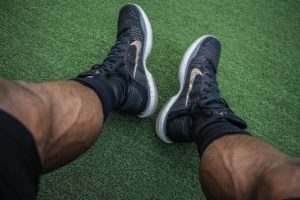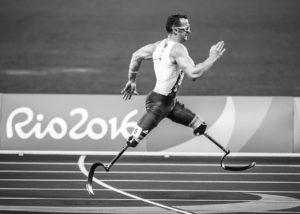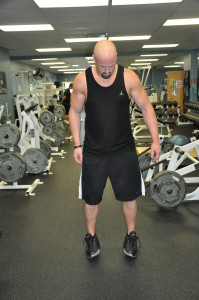An area that most athletes neglect is ankle strengthening. Because such extreme demands are placed  on the ankle during speed and agility work, special care should be taken to enhance the function of this area. This does not take a tremendous amount of time, but the effort may help reduce the risk of injury as well as improve sport performance.
on the ankle during speed and agility work, special care should be taken to enhance the function of this area. This does not take a tremendous amount of time, but the effort may help reduce the risk of injury as well as improve sport performance.
The importance of foot and ankle rigidity cannot be understated.
When the foot hits the ground during a sprinting motion, there is always a certain amount of “joint deformation.” What I mean is that the joint gives way and bends as the foot hits the ground.
When the fastest people in the world run, there is very little joint deformation. In fact, Usain Bolt’s ankle barely moves at all when his foot hits the ground. This allows allow of the power from his hips to transfer through his foot and into the ground. Because his ankles remain rigid, all of that force propels him forward.
If his ankle was not rigid, and deformed as his foot hit the ground, a lot of the power would be lost because his ankle couldn’t handle the force. This would slow him down, and this is exactly what happens to most of us.
 The concept of rigidity is also exactly why some people thought the South African sprinter Oscar Pistsorius, the Blade Runner (yes, the guy who killed his girlfriend), was cheating by using prosthetic limbs. His prosthetic limbs had excellent rigidity with just enough spring in them that they allowed him to utilize all the force from his hips and apply it to the ground.
The concept of rigidity is also exactly why some people thought the South African sprinter Oscar Pistsorius, the Blade Runner (yes, the guy who killed his girlfriend), was cheating by using prosthetic limbs. His prosthetic limbs had excellent rigidity with just enough spring in them that they allowed him to utilize all the force from his hips and apply it to the ground.
Our goal with ankle strengthening exercises is to get our ankles to be more rigid and work more like those prosthetic limbs.
The first consideration is properly warming up the foot and ankle. A complete warm up routine should include some kind of ankle rolls/circles to dynamically activate the musculature in the lower leg. If there is a history of ankle injuries or shin splints, toe taps and bodyweight toe raises can be added to the routine. The rest of the warm up routine should prepare the ankle for training, but you may even want to add a few quick response jumps like the 4-square plyometric drill to focus on ankle preparation.
Try the Ankle Circle drill I’ve used to effectively warm-up and strengthen the lower leg musculature with many  athletes. To perform the exercise, stand on both feet with your weight on the outside of each heel. Slowly rock your weight forward so that it’s on the outside of your forefoot (basically on your smallest toe). Continue by transferring your weight to the inside of your big toes, then backward to the inside of your heel. From there, reverse the direction so you’ll rock to the inside of your big toe, to the outside of your little toe, and back to the outside of the heel. That is one repetition. You’ll want to perform 10 repetitions.
athletes. To perform the exercise, stand on both feet with your weight on the outside of each heel. Slowly rock your weight forward so that it’s on the outside of your forefoot (basically on your smallest toe). Continue by transferring your weight to the inside of your big toes, then backward to the inside of your heel. From there, reverse the direction so you’ll rock to the inside of your big toe, to the outside of your little toe, and back to the outside of the heel. That is one repetition. You’ll want to perform 10 repetitions.
Some athletes have a difficult time just getting through this range of motion because they may lack mobility or kinesthetic awareness. Just continue to work through this exercise to the best of your ability and you will undoubtedly begin to feel the lower leg and foot musculature begin to engage.
If there is no acute injury, and ankle conditioning is a concern, the 4-square drill is an excellent way to train the lower leg and ankle. Working through different patterns allows the ankle and foot to learn sound mechanics and may improve proprioception, or body control.
Another ankle strengthening exercise that can even be used to rehabilitate an injury is the Stork Drill. This drill begins by simply standing on one foot. If you have a history of ankle injuries, this alone may be surprisingly difficult. Once this can easily be done for at least 30 seconds, balance can be challenged with unstable surfaces or playing catch, which will more fully engage the lower leg and foot musculature to maintain balance. This has been shown to stimulate the proprioceptors of an injured leg. Perform these drills once or twice a week for 2-4 minutes to keep the ankles functioning optimally.
 Foot poppers are another exercise I developed as a foot placement teaching drill that can also be used as a high-intensity plyometric drill to increase the “stiffness” of the lower leg. A foot popper needs to be done with great caution and its use should be limited.
Foot poppers are another exercise I developed as a foot placement teaching drill that can also be used as a high-intensity plyometric drill to increase the “stiffness” of the lower leg. A foot popper needs to be done with great caution and its use should be limited.
To perform a foot popper, stand on one leg with the support leg bent slightly. You may choose to lean against a wall/object slightly to mimic the forward lean used when accelerating. The front leg starts with the hip, knee and ankle flexed tightly in front of you. The drill will begin just like a wall push drill.
Drive the leg down into the ground through the ball of the foot, keeping the ankle flexed. If done correctly with a rigid ankle, the downward force you put into the ground will “pop” you upwards slightly. Based on the stretch shortening cycle theory, the musculature will contract quickly in response to the fast, powerful stretch placed on it when the foot hits the ground. This reaction will send you upwards. Keep in the mind that a limited number of reps (less than 10) should be performed and that striking the ground through the ball of the foot is critical. Striking with the toes or heel may cause injury, so be sure good technique is being used.
Jumping rope or simply performing hops in place with a rigid ankle is another great exercise. Just be sure to maintain a slightly flexed position of the ankle and limit the amount of deformation that occurs during each landing. You can also hop one foot at a time to increase the intensity. I recommend doing bouts of 30-60 seconds.
These drills are simply intended to strengthen the musculature and work toward greater ankle rigidity. Agility and speed work must always be included at some point to stimulate the specific neural pathways used in sport movement.

great article,
What is your opinion on this video?
http://strongmadesimple.com/blog/2012/08/5-drills-for-ankle-mobility
I don’t hate it, but I’m not a huge fan either. My biggest concern is that I think it would be very difficult to get anyone to do this routine on a consistent basis. I don’t think too many people are going to take their shoes off in a gym, but that’s a minor issue. I don’t really care for the stuff on the knees because I think it would give a lot of people trouble. I like the rotational stuff and the “perfect stretch” deal, but I think there are better ways to get rotational mobility in the ankle done like doing a simple calf stretch and rotating or getting in a “kneeling hip flexor stretch” position, pushing the knee forward and rotating it while the foot remains straight.
I like people getting creative and making stuff up, but it has to be easy to implement and better than other alternatives to really be useful. So, none of it is terrible, but I don’t think I will use any of that. Just my opinion.